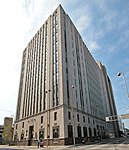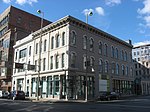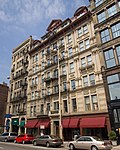Duke Energy Convention Center
1968 establishments in OhioBuildings and structures in CincinnatiConvention centers in OhioEvent venues established in 1968Tourist attractions in Cincinnati ... and 1 more
World Choir Games venue

The Duke Energy Convention Center is a convention center located in downtown Cincinnati, Ohio, United States, covering two city blocks bounded by Elm Street, 5th Street, 6th Street, and Central Avenue.
Excerpt from the Wikipedia article Duke Energy Convention Center (License: CC BY-SA 3.0, Authors, Images).Duke Energy Convention Center
Plum Street, Cincinnati Central Business District
Geographical coordinates (GPS) Address Website External links Nearby Places Show on map
Geographical coordinates (GPS)
| Latitude | Longitude |
|---|---|
| N 39.101314 ° | E -84.517495 ° |
Address
Duke Energy Convention Center (Cincinnati Convention Center)
Plum Street
45203 Cincinnati, Central Business District
Ohio, United States
Open on Google Maps










